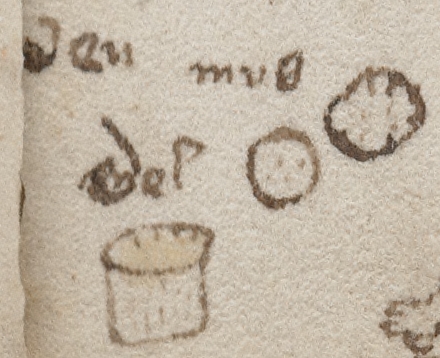Lately, I checked out f66r in a different context, and these days the page also showed up on Nick Pelling’s blog.
You may recall the page; it’s outstanding features are a column of individual words and individual letters next to the body of the text, and, near the bottom of the page, a little bit of marginalia:
- A string of Voynich words
- A reclining woman*)
- Some short words in what seems to be latin letters
- A few obscure items

Now, the latin letters have at times been interpreted as “der mus del”, meaning “der Mussteil” in contemporary German — supposedly a kind of minimum dowry or heritage. (Googling the term comes up with nothing, BTW.)
But let’s take a closer look at this part of the page…

You will notice that the “d” of the supposed “del”-word has overwritten a letter which had previously been there, and which could very well haven been an “m”.
If we accepted this reading, some things would start to fall into their place: “mus” also translates as “mush” or “porridge”, and “mel” (rather than “del”) means “flour” (cognate to “meal”),**) so at least we would have two words covering the same topic. It’s also not unreasonable (note the less-than bold phrasing) to assume the items lying around might be bread or cake, which would fit better in the context of food than dowry. (The thing on the bottom left looks suspiciously like a muffin to me, but it’s been some time since breakfast…)
Of course, this raises more questions:
- Why was the “m” erased and replaced with a “d”, rather than simply blotting out the “m”?
- What is the context of the reclining woman, the bread, and the VM in general?
One of the side benefits of this observation would be that, if it can be confirmed that the correct reading is “mus mel”, it would give us a hint to the handwriting used in the other marginalia, which in turn might enable us to finally read what’s written on f116v.
*) The figure has often been called “a dead or dying woman”, but to me that’s already a bit too much of an interpretation. That she’s stroking her belly doesn’t necessarily mean she’s in her last throes…
**) Pending confirmation that this would have been the spelling used in around 1450…
A couple of comments (from The Curse, pp.25-26):-
* The reclining nymph has a barely visible patch of yellow paint on her stomach, which looks to be the same colour as the yellow paint in the ‘pot’.
* If you twiddle around with the brightness and contrast, you’ll notice not only (as you point out) that the final ‘m’ has been overwritten by a ‘d’, but also that the ‘ss’ appears to be overwriting something else (probably a ‘c’), and that the first letter on the leftmost word also seems to be emended. I guessed at “y’en muc mal” for the phrase, but do acknowledge that the ‘y’ looks like the ‘p’ from ‘pox’ on f116v.
“Der” looks much more to me like “den”, which is Dutch. The reading “Den muf me[e]l” means “The mouldy meal(flour)”, which could explain why she’s holding her stomach… it didn’t taste too good. (“Mus” could be “mouse” according to a Friesch dictionary, but that doesn’t make any sense.)
In modern spelling:
http://translate.google.com/translate_t#nl|en|De%20muf%20meel.
(Sorry for taking so long to answer…)
Abadidea, and do you have any idea what’s behind the replacement of m with d?
Would mus del make any more sense in Dutch? Is/was mus a dutch word like german “Muß”? (I really don’t read the second word as muf…)
“Mus” is apparently a sparrow (Dutch is my second language) so that’s not very helpful. I read “muf” by thinking of one of those cursive f’s being drawn very small with ink and the ends running together to make something like a theta. If the woman is about an inch tall (which I think is the scale here) then it’d be very easy to mess up a letter.
Is it possible that the ‘m’ actually overstrikes the ‘d’? It looks to me like it could go either way…
The “d” is much larger than the other letters, including the “m” with which it overlaps. This makes it at least look like the “d” is supposed to obscure an earlier “m”. But, as always, I wouldn’t count on it.
If we can’t even make sense of the latin letters, how are we ever supposed to read the Voynichese…? :-/